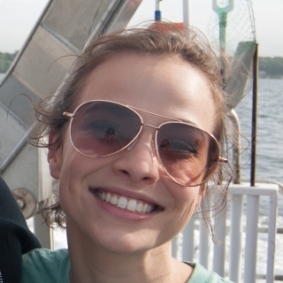Eight students will be presenting the summer work at the Ocean Sciences Meeting in March 2022!
Emily Wolcott, Delaware Valley University (PA)
Class Year:
2017Mentor:
Sairah Malkin, Ph.D.Project Title:
The Biogeography of Sulfide Oxidizing Bacteria in a Tidal Sub-Estuary of the Chesapeake Bay
Abstract:
Sulfide oxidizing bacteria hold ecological importance in their ability to convert naturally formed, yet toxic, hydrogen sulfide into the inert sulfate in marine sediment. Two sulfide oxidizing bacteria, Beggiatoa and cable bacteria, share common territory in marine sediments; however, not much is known about their interactions and natural distribution. The factors controlling the sulfide oxidizing bacterial distribution are not known, but it is hypothesized that salinity may be one of the determinants. To test this hypothesis, we sampled across a salinity gradient in the Choptank River and into the Chesapeake Bay, Maryland, collecting sediments from sites at conductivities from < 1 mS/cm up to 18 mS/cm. We found that Beggiatoa were at low abundance at all sites except at station on the west side of Chesapeake Bay, indicating that salinity alone does not define its geochemical niche. Enumeration of cable bacteria is still on-going, with preliminary results identifying their presence at the mid-Bay station in Chesapeake Bay.



